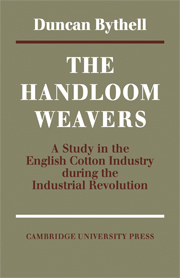Book contents
- Frontmatter
- Contents
- Preface
- Introduction
- Map of the weaving towns and villages of north-east Lancashire in 1821
- 1 Problems and sources
- 2 The organization of the industry
- 3 The labour force
- 4 The coming of the powerloom
- 5 Wages: (I) The piece-rate
- 6 Wages: (II) Earnings and the standard of living
- 7 Public opinion and the handloom weavers
- 8 Organized industrial action among the cotton handloom weavers
- 9 The weavers and radical politics
- 10 The problem of poverty
- 11 Displacement and disappearance
- Appendix 1 Some piece-rate series
- Appendix 2 The piece-rate and the price of food
- Appendix 3 G. H. Wood's estimates of average weekly earnings
- Bibliography
- Index
6 - Wages: (II) Earnings and the standard of living
Published online by Cambridge University Press: 07 October 2011
- Frontmatter
- Contents
- Preface
- Introduction
- Map of the weaving towns and villages of north-east Lancashire in 1821
- 1 Problems and sources
- 2 The organization of the industry
- 3 The labour force
- 4 The coming of the powerloom
- 5 Wages: (I) The piece-rate
- 6 Wages: (II) Earnings and the standard of living
- 7 Public opinion and the handloom weavers
- 8 Organized industrial action among the cotton handloom weavers
- 9 The weavers and radical politics
- 10 The problem of poverty
- 11 Displacement and disappearance
- Appendix 1 Some piece-rate series
- Appendix 2 The piece-rate and the price of food
- Appendix 3 G. H. Wood's estimates of average weekly earnings
- Bibliography
- Index
Summary
Unfortunately, a detailed knowledge of the course of piecerates in cotton weaving during the industrial revolution is not sufficient to enable us to form any definite conclusions about the weavers' standard of living over the same period. For it is very difficult to convert these piece-rates into actual earnings. Yet since we know so little about real earnings, it is worthwhile making some attempt to establish a relationship. Even in the 1830s commissioner Hickson found it difficult to get hard facts, although he and other investigators heard a good many estimates of what a ‘good weaver’ or the ‘average weaver’ ought to be earning. Hickson wrote: ‘The object of the weaver being to procure government interference in his favour, he has no disposition to weaken his case of hardship and distress by stating the whole of his resources; and he will withold the knowledge of every fact tending to show that he has sometimes the command of other means of alleviating his sufferings than appear to the inquirer.’
Although the piece-rate should be able to help us make up for this deficiency, in practice its value is limited. Since earnings in a piece-rate industry are strictly proportional to output, the piecerate can be useful only if we can be sure that output did not differ greatly either from one worker to another or over time. Yet neither assumption can be made about cotton weaving, where output varied enormously.
- Type
- Chapter
- Information
- The Handloom Weavers , pp. 114 - 138Publisher: Cambridge University PressPrint publication year: 1969



